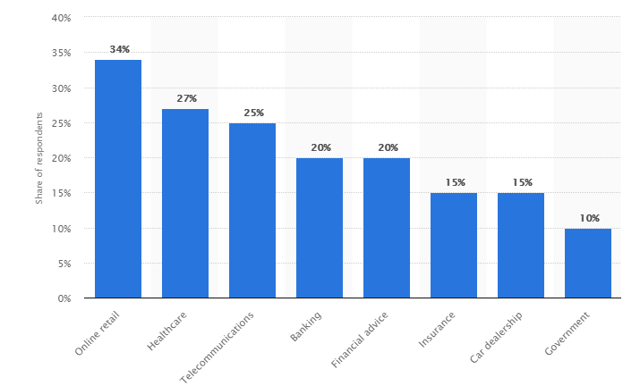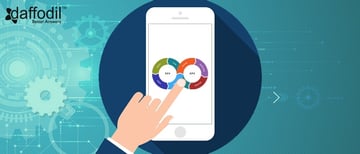
The accelerated market hype around Artificial Intelligence has made it a buzzword of almost every industry. Businesses, irrespective of their industry are interested to invest in the potential of AI to automate, assist, and augment various value-based tasks.
Artificial Intelligence (AI) is the ability of systems (platforms, tools, or apps) to respond to the inputs received, without being explicitly programmed for it. This response is based on algorithms, usage analysis, datasets, and other cognitive observations.
While there are prejudices that AI will replace humans; the current possibilities of AI technologies showcase that it will augment the human capabilities. At the core, AI is training the systems to perform certain tasks, better and faster than humans.
AI in Business Applications: Discussing the Scope
At present, there are a number of businesses embracing the power of AI into their applications. Smart Reply in Gmail, Face Recognition in Facebook, Spam Filtering in email clients, Product Recommendation on eCommerce platforms are some of the examples which exhibits that businesses have started to encompass AI to improve their products.
“By 2019, application functions based on articial intelligence will be pervasive in 90% of enterprises globally.”- Gartner
AI is enabling the machines to help humans by automating repetitive/routine tasks, speed up decision making, and assist them to invest in more valuable tasks. Here are a few ways AI can add value to business applications, through its varied technologies.
Improved Customer Service and Support (Virtual Agents)
Virtual Customer Assistants (VCAs) is one of the widely adopted use cases of AI. Predictive customer analytics, sentiment analysis, speech recognition are some of the AI technologies that are operational at the backend.
Virtual Assistants engage the users 24/7, across various communication channels like web chat, email management, IVR, chatbot, or messaging.
Chatbots are one of the finest examples of virtual assistants in use today, that also keeps human in loop for supervised advise. For example: For answer to the queries that are out of its scope (like estimating cost for something), a bot can schedule a meeting with the human-in-charge. In business settings, an AI meeting assistant can take this a step further by automatically transcribing conversations and summarizing key action points, helping teams stay productive and organized.

Customer preference to interact with virtual assistant/chatbot, as of 2017 (Source: Statista)
Recommendation and Personalization (Machine Learning)
Cognitive learning (known as Machine Learning) is the ability of a system to learn through previous inputs/outputs and make a decision. Such functionality can be replicated into business applications through machine learning models and algorithms that are exposed to a number of cases or data sets. Such a functionality can enable applications to render personalized experience to users, help in data mining, make classification simpler, and much more.
READ MORE: How Machine Learning will Enhance User Experience in Mobile Apps
Data-to-Text Conversion (Natural Language Generation)
There are a number of databases and data sets, working at the backend. Extensive in size and dynamic in nature. How the applications process this data and deliver it to users in a language that they understand? For such data conversion into natural language, NLP (a subset of AI) helps.
“Hundreds of customers like Tableau, Microsoft, The Associated Press, Cisco, Yahoo, and PwC use Wordsmith to generate more than 1.5 billion pieces of content per year.” -claims WordSmith, a Natural Language Generation Platform that turns data into narrative stories.
NLG can be a productivity aid to various weather forecasting applications to convert processed data into text or audio format and similar concepts.
Audio-to-Text Conversion (Speech Recognization)
Business applications that require to receive audio inputs for processing can make the most of speech recognization abilities. Voice response interactive systems (like Alexa), mobile apps (Google Translate) exemplifies how speech recognization can be smartly integrated into business applications.
Automated Data Processing (Intelligent Things)
Consider a collaboration between IoT and AI. The best part about IoT is it generates a lot of data. On the other hand, AI needs a lot of data for preciseness in results. This collaboration between the two can be utilized in a number of ways like:
IoT as the Input of AI System: Imagine a wearable collecting health vitals like pulse rate, body temperature, rate of breathing. The wearable is configured with a healthcare app, which keeps processing the data received from wearable and triggers notification if an unusual behaviour is analyzed. That’s how AI and IoT can go hand-in-hand.
How to Develop AI-Driven Applications
For building AI enabled solutions, businesses can choose to set up an AI infrastructure and develop their own algorithms to develop applications. While this is complex, time-taking, and an expensive affair, nowadays, Off-the-Shelf AI solutions are making it simpler than ever to embed AI into business applications.
Also known as Artificial Intelligence as a Service (AIaaS)), Off-the-Shelf AI solutions offer pre-trained algorithms that reduce the overall time to integrate AI into applications, reduce costs, and comparatively require less intellect resources. Tech giants like Amazon (Machine Learning at AWS), Microsoft (Cognitive Services), Google (Cloud AI), are in the forefront to deliver Off-the-Shelf AI solutions.
These hosted services are a great asset to app development teams. While some of the pre-trained models might offer basic functionality, they can be upgraded with incremental learning in order to add functionalities, specific to requirements.
Another option for integrating AI into business applications is through AI frameworks. These frameworks are meant to simplify specific functionalities like object identification, pattern recognition, natural language processing etc. This approach for AI driven app development renders to certain need of applications and are cost-effective.
Want to give your business a boost with AI? Take our 30 minutes free consultation with the AI expert and understand the possibilities that AI can add to your business application.




